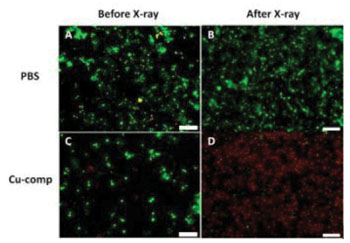Nanoparticle Created for Cancer Therapy
By LabMedica International staff writers
Posted on 30 Apr 2014
A physicist working to create a luminescent nanoparticle to use in security-related radiation detection may have instead developed a new tool for photodynamic cancer therapy. Posted on 30 Apr 2014
Wei Chen, professor of physics and co-director of University of Texas (UT) at Arlington (USA) Center for Security Advances Via Applied Nanotechnology, was testing a copper-cysteamine (Cu-Cy) complex created in his lab when he discovered mysterious decreases in its luminescence, or light emitting power, over a time-lapse exposure to X-rays. Researching further, he discovered that the nanoparticles, called Cu-Cy, were losing energy as they emitted singlet oxygen—a toxic byproduct used to damage cancer cells in photodynamic therapy.

Image: X-ray destruction of human breast cancer cells using Cu-Cy particles. The images show the live cancer cells stained green and the dead cells stained red (Photo courtesy of Wei Chen/UT Arlington).
Because Prof. Chen also is leading federally funded cancer research, he knew he had found something unique. Testing revealed that the Cu-Cy nanoparticles, combined with X-ray exposure, significantly slowed tumor growth in lab studies. “This new idea is simpler and better than previous photodynamic therapy methods. You don’t need as many steps. This material alone can do the job,” Prof. Chen said. “It is the most promising thing we have found in these cancer studies and we’ve been looking at this for a long time.”
Prof. Chen’s research will be published in the August 2014 edition of the Journal of Biomedical Nanotechnology. The article was published online April 2014. The University has also filed a provisional patent application on the new complex.
Photodynamic therapy (PDT) harms cancer cells when a photosensitizer introduced into tumor tissue produces toxic singlet oxygen after being exposed to light. In some studies, this light exposure is done through use of visible or near-infrared lasers. Others have found more success by also introducing luminescent nanoparticles into the tumor. Researchers activate the luminescent nanoparticle with near-infrared light or X-rays, which in turn activates the photosensitizer.
Both techniques have limitations for treating deep tissue cancers. They are either ineffective or the light source needed to activate them does not penetrate deep enough. Prof. Chen reported that X-ray-inducible Cu-Cy particles surpass current photosensitizers because the X-rays can penetrate deep into tissue. Furthermore, Cu-Cy nanoparticles do not need other photosensitizes to be effective so the treatment is more convenient, efficient and cost-effective.
“Dr. Chen’s commitment to his work in cancer-related therapy, as well as his work in the area of homeland security, demonstrates the wide-ranging applications and great value of basic science research,” said Carolyn Cason, vice president for research at UT Arlington. “These advances have the potential to change the way some cancers are treated and make therapy more effective—a benefit that would be boundless.”
Prof, Chen’s team assessed the Cu-Cy on human breast and prostate cancer cells in the lab and found it to be an effective treatment when combined with X-ray exposure. In one esperiment, for example, a tumor treated with Cu-Cy injection and X-ray exposure stayed virtually the same size over a 13-day period while a tumor without the full treatment grew by three times.
Another benefit of the new nanoparticle is a low toxicity to healthy cells. Furthermore, Cu-Cy’s intense photoluminescence and X-ray luminescence can be employed for cell imaging, according to the scientists. Details of the crystal structure and optical characteristics of the new complex are slated for publication in an upcoming paper from the Journal of Materials Chemistry. Prof. Chen reported that additional research would include reducing the size of the Cu-Cy nanoparticle to make it more easily absorbed in the tumor tissue. “For cancer, there is still no good solution yet. Hopefully this nanoparticle can provide some possibilities,” he said.
Related Links:
University of Texas at Arlington













